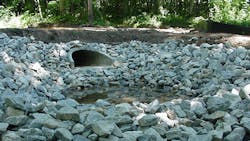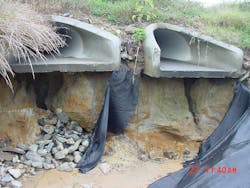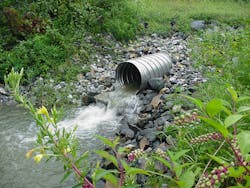The Delaware Department of Transportation (DelDOT) was recently tasked with developing a design guidance document for pipe outfall protection to aid its designers for use on their design projects.
The concentration for this guidance focuses on pipes less than or equal to 60-inch round diameter (or equivalent). Anything larger than this size is considered a bridge; hence, it would require additional coordination with a Bridge Design section. In Delaware, most of the state is located in the coastal plain region except for a small portion of the upper part, which is in the piedmont region.
In layman’s terms, Delaware is very flat, and DelDOT designers usually have more problems with trying to get enough slope on a pipe system to reach minimum clean out velocity.
Even with the mostly flat slopes, scour at pipe outfalls is still prevalent. In practice, most pipe outfalls (and intersecting swales) exhibit some type of scour even if the velocities and amount of flow are small.
Exploring Pipe Outfall Protection
Channel lining selections are fine for when the flow is at a steady state position, but what about that small area next to the pipe outfall? With the main function of outfall protection being to disrupt the concentrated energy, how best and easily can that area be secured to mitigate erosion?
In order to be useful for maintenance personnel in the field, preliminary research on the background of outfall protection and other states practices in this area were conducted and a multitude of studies based on different research projects were consulted.
Many states and municipalities encapsulate their approach differently. The two main design criteria that most areas follow are the processes found in Hydraulic Engineering Circular 14 (HEC 14) and two charts created by the Soil Conservation Service — now known as the National Resources Conservation Service (NRCS). There are also different states and agencies that use a mixture of the two, as well as other criteria.
HEC 14 is an excellent resource and, for the purposes stated above, the document’s discussion of culverts contains the most relevant subject matter. The discussion of riprap aprons was also fairly succinct, but the riprap basin calculations were more involved in the documentation. Also, the Federal Highway Administration (FHWA) HY 8 Culvert Hydraulic Analysis Program is based on HEC 14, so, for situations that include only a straight pipe run open on both ends, that program could be used for sizing a riprap basin.
From a designer perspective, HEC 14 and HY 8 are good options. However, if the field engineer or maintenance personnel wanted a simpler procedure that could be done quickly in the field, the riprap apron could be calculated fairly easily, but the riprap basin calculations would be too complicated. Plus, the HEC 14 length and width apron dimensions often seem to be larger than what is needed in real-world applications.
With the perceived larger than needed size, right of way concerns come into play. Again, is there potentially a simpler way to calculate a length and width, which would work for DelDOT and still be viable from an engineering aspect?
NRCS Charts
The NRCS charts give different dimensions than HEC 14, — plus, the individual charts appear to be a combination of two charts imposed on one another, created sometime in the 1970s or 1980s.
While the origin of the charts is unknown, Appendix D in HEC 14 states the charts appear to be based on J.P. Bohan’s research report, H-70-2, Erosion and Riprap Requirements at Culvert and Storm-Drain Outlets, conducted in 1970.
From a designer standpoint, sizing riprap aprons with the charts is simple and quick. For personnel out in the field, it could be a little cumbersome carrying those around. And those charts are only good for riprap aprons, not riprap basins.
Riprap Alternatives
For most pipe outfall protections, riprap is the standard. But, for the thousands of pipes, road crossing culverts, driveway culverts, and more that have lower velocity and total flow values, what about using a more flexible armoring application? How would that sizing be accomplished? There are quite a few products on the market that should work, according to the manufacturer’s literature.
But with no independent testing of these products — at least, not in the way that the National Transportation Product Evaluation Program (NTPEP) does for flexible channel linings such as erosion control blankets (ECB) and turf reinforcement matting (TRM), it can be hard to determine feasibility.
DelDOT has tried a few test cases using TRM at a pipe outfall for scour protection but, in almost all cases — it wasn’t as successful as hoped.
There is a strong promise for some of the other more robust products that could do a good job of preventing scour and promoting a greener approach to Delaware’s pipe outfall protection needs. This would help tremendously with cost, installation, long term maintenance, and appearance. Yes, rock is about as natural as it can get and engineers really like it, but homeowners and maintenance personnel — who have to cut around it and spray herbicides — may have a different opinion.
Perhaps a happy medium can be reached by simplifying the formulas used while still maintaining an engineered functional approach; at least for Delaware’s needs. What works here may not be the best solution for other states and municipalities, so stormwater managers are encouraged to take a step back and evaluate their pipe outfall protection design process. SW
Vince Davis is a professional engineer in Delaware and has been with the Delaware Department of Transportation for over 26 years, mostly working in the fields of stormwater management and erosion and sediment control.
Published in Stormwater magazine, February 2022.








